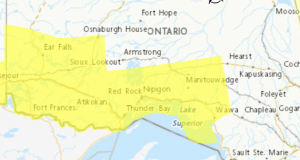Lake Superior and Lake Michigan-Huron have both continued their seasonal declines in October. As a result of the continued drier than average weather and water supply conditions, water levels on Lake Superior remain slightly below the seasonal long-term average. Weather and water supply conditions were wetter than average in the Lake Michigan-Huron basin in October, and as a result, Lake Michigan-Huron water levels remain above the seasonal long-term average. Lake Superior outflows continue to be set in consideration of water levels upstream and downstream.
The Board expects the total outflow to be 1,890 m3/s (66.7 tcfs) in November, which is as prescribed by Lake Superior Regulation Plan 2012. The gate setting at the Compensating Works will be maintained at the setting equivalent to one half gate open (Gates #7 through #10 partially open 20 cm (7.9 in)). There will be no change to the setting of Gate #1, which supplies a flow of about 15 m3/s to the channel north of the Fishery Remedial Dike.
Weather and water supply conditions were drier than average in the Lake Superior basin and wetter than average in the Lake Michigan-Huron basin in October. As a result, Lake Superior declined 5 cm (2.0 in), while on average the lake declines 3 cm (1.2 in) in October. Lake Michigan-Huron declined 4 cm (1.6 in) last month, while the average historical decline is 7 cm (2.8 in) in October. At the beginning of November, Lake Superior is 6 cm (2.4 in) below the long-term average water level (1918 – 2020) and 29 cm (11.4 in) below the level of a year ago. Lake Michigan-Huron is 42 cm (16.5 in) above average 38 cm (15 in) below the level from last year, and 63 cm (24.8 in) below the record level set in 1986.
Lake Superior and Lake Michigan-Huron water levels typically decline in November. Depending on the weather and water supply conditions during the next month, Lake Superior may rise slightly or decline by as much as 10 cm (4 in) in November. Lake Michigan-Huron water levels could decline by as much as 13 cm (5.1 in).
Shoreline businesses and property owners are reminded that the Great Lakes – St. Lawrence River Adaptive Management (GLAM) Committee continues to host an online questionnaire to allow for direct reporting on impacts related to high water conditions: https://ijc.org/glam/questionnaire.
The International Lake Superior Board of Control is responsible for regulating the outflow of Lake Superior and managing the control works on the St. Marys River. Under any regulation plan, the ability to regulate the outflow from Lake Superior does not mean that full control of lake levels is possible. This is because the major factors affecting water supply to the Great Lakes, precipitation, evaporation, and runoff cannot be controlled, and are difficult to accurately predict. Outflow management cannot eliminate the risk of extreme water levels from occurring during periods of severe weather and water supply conditions. Additional information can be found at the Board’s homepage: https://ijc.org/en/lsbc or on Facebook at: https://www.facebook.com/InternationalLakeSuperiorBoardOfControl
- Batchewana FN & Alamos Gold Begin Next Phase of the Mine Connector Transmission Project - December 16, 2025
- Mixed Curling Standings – December 13 - December 13, 2025
- Ladies Curling Standings – December 12th - December 12, 2025
 Wawa-news.com You can't hear the 'big picture'!
Wawa-news.com You can't hear the 'big picture'!


